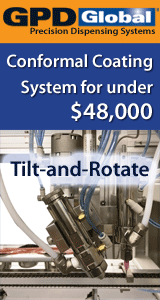Corrosion Resistance of Different PCB Surface Finishes in Harsh Environments
Published: |
August 9, 2012 |
Author: |
Mustafa Özkök, Joe McGurran, Hugh Roberts. Kenneth Lee, Guenter Heinz |
Abstract: |
First published in the 2012 IPC APEX EXPO technical conference proceedings. Corrosion resistance is becoming one of the most important topics in the electronics industry. Corrosion results in field failures and huge losses, which annually total several bi... |
|
August 15, 2012 Dear Dave, adding phosphor into the nickel layer increases the hardness and improves the corrosion resistance and makes it other side also more resistant for the Gold deposition (Au-thickness is lower), therefore the solder wetting is slightly less compared to Med. Phos ENIG but still much better than OSP, immersion Tin or Immersion Silver. The Phoshorus enrichment in case of Black Pad is something totally diffrent and is not related to the High Phosphor ENIG Process. In case you drop me an e-mail I can forward you more details. vbr Mustafa January 17, 2013 Following-up on the above thread, Mustafa emailed me the following papers on black pad: * Identification and Prevention of “Black Pad” [http://www.smtnet.com/library/index.cfm?fuseaction=view_article&article_id=1859 ] * Solving the ENIG Black Pad Problem: An ITRI Report on Round 2, F.D.Bruce Houghton, Celestica, Inc., North York, Ontario, Canada [http://www.smtnet.com/library/index.cfm?fuseaction=view_article&article_id=1860 ] August 13, 2012 Dear Selha, thank you for your comment. Of corse this paper is only some little picture, more percisely a part of the "corrosion resistance" picture of the surface finish world. The aim of this paper was too look only from the corrosion resistance point of view on the surface finishes. HASL was not avalible for us at the time when we run these tests. I agree that it would made the data more complete. Adding Phosphor into the ENIG maybe was not the right for your application but High Phosphor ENIG is well used since more than 10 years in the Mobile phone area successfully. Therefore it depends on the application and the requirements which surface finish may fit to which application. There are pros and cons for each surface finish.
|
|
Company Information:
- Nov 15, 2020 - Designing a High Performance Electroless Nickel and Immersion Gold to Maximize Highest Reliability
- Sep 02, 2020 - Developments in Electroless Copper Processes to Improve Performance in amSAP Mobile Applications
- Mar 12, 2020 - Filling of Microvias and Through Holes by Electrolytic Copper Plating –Current Status and Future Outlook
- Sep 19, 2019 - How Detrimental Production Concerns Related to Solder Mask Residues Can Be Countered by Simple Operational Adaptations
- Apr 10, 2019 - Soldering Immersion Tin
- See all SMT / PCB technical articles from Atotech »
More SMT / PCB assembly technical articles »
- Apr 11, 2022 - iNEMI Webinar 07.07.2021 - PCB Cleaning | ZESTRON Americas

- Jan 28, 2022 - Open Radio Unit White Box 5G | Whizz Systems

- Nov 10, 2021 - Understanding the Cleaning Process for Automatic Stencil Printers | ITW EAE

- Oct 20, 2021 - PCB Surface Finishes & The Cleaning Process - A Compatibility Study | ZESTRON Americas

- Oct 06, 2021 - Cleaning Before Conformal Coating | ZESTRON Americas

- Browse Technical Library »
Corrosion Resistance of Different PCB Surface Finishes in Harsh Environments article has been viewed 964 times








davef
August 14, 2012
Thanks for your paper. It was fascinating to learn that the corrosion resistance of immersion tin is the reason that it’s preferred in the automotive sector. the corrosion resistance properties of Hi-P ENIG surprised me. I always associated Hi-P ENIG with ‘black pad.’ Please help me understand more about Hi-P ENIG and black pad.